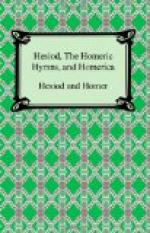This curious work dates in its present form from the lifetime or shortly after the death of Hadrian, but seems to be based in part on an earlier version by the sophist Alcidamas (c. 400 B.C.). Plutarch ("Conviv. Sept. Sap.”, 40) uses an earlier (or at least a shorter) version than that which we possess (18). The extant “Contest”, however, has clearly combined with the original document much other ill-digested matter on the life and descent of Homer, probably drawing on the same general sources as does the Herodotean “Life of Homer”. Its scope is as follows: 1) the descent (as variously reported) and relative dates of Homer and Hesiod; 2) their poetical contest at Chalcis; 3) the death of Hesiod; 4) the wanderings and fortunes of Homer, with brief notices of the circumstances under which his reputed works were composed, down to the time of his death.
The whole tract is, of course, mere romance; its only values are 1) the insight it give into ancient speculations about Homer; 2) a certain amount of definite information about the Cyclic poems; and 3) the epic fragments included in the stichomythia of the “Contest” proper, many of which — did we possess the clue — would have to be referred to poems of the Epic Cycle.
ENDNOTES:
(1) sc. in Boeotia, Locris and Thessaly: elsewhere
the movement
was forced and unfruitful.
(2) The extant collection of three poems, “Works
and Days”,
“Theogony”,
and “Shield of Heracles”, which alone have
come
down to us complete,
dates at least from the 4th century
A.D.: the title
of the Paris Papyrus (Bibl. Nat. Suppl.
Gr.
1099) names only these
three works.
(3) “Der Dialekt des Hesiodes”, p. 464:
examples are AENEMI (W.
and D. 683) and AROMENAI
(ib. 22).
(4) T.W. Allen suggests that the conjured Delian
and Pythian
hymns to Apollo ("Homeric
Hymns” III) may have suggested
this version of the
story, the Pythian hymn showing strong
continental influence.
(5) She is said to have given birth to the lyrist
Stesichorus.
(6) See Kinkel “Epic. Graec. Frag.”
i. 158 ff.
(7) See “Great Works”, frag. 2.
(8) “Hesiodi Fragmenta”, pp. 119 f.
(9) Possibly the division of this poem into two books
is a
division belonging solely
to this `developed poem’, which
may have included in
its second part a summary of the Tale
of Troy.
(10) Goettling’s explanation.
(11) x. 1. 52
(12) Odysseus appears to have been mentioned once
only — and
that casually —
in the “Returns”.
(13) M.M. Croiset note that the “Aethiopis”
and the “Sack” were
originally merely parts
of one work containing lays (the
Amazoneia, Aethiopis,
Persis, etc.), just as the “Iliad”
contained various lays
such as the Diomedeia.
(14) No date is assigned to him, but it seems likely




